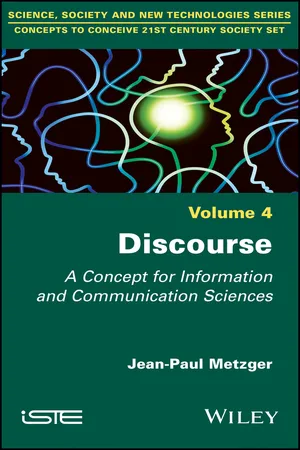
Discourse
A Concept for Information and Communication Sciences
Jean-Paul Metzger
- English
- ePUB (mobile friendly)
- Available on iOS & Android
Discourse
A Concept for Information and Communication Sciences
Jean-Paul Metzger
About This Book
Discourse is not just a means of expressing thought; it is also an autonomous body, an act through which we aim to achieve a certain effect. Modern linguistics proposes a broader definition of discourse, as a discrete and unique enunciative process, where the speaker or author makes language concrete through speech (in the Saussurian sense), and describes the various acts (oral, illocutionary, perlocutionary) that discourse performs. This book examines discourse, an object of analysis and criticism, from a wide range of perspectives. Among the concepts explored are the contributions of rhetoric in the art of discourse, the evolution of multiple approaches and the main methods of discourse analysis conducted by a variety of researchers. The book deepens our knowledge and understanding of discourse, a concept on which any research related to information and communication can be based.
Frequently asked questions
Information
PART 1
Epistemological Foundations
Introduction to Part 1
“[…] nevertheless assumes that statements are not presented as sentences or sequences of sentences but as texts. However, a text is a specific mode of organization that must be studied as such by relating it to the conditions in which it is produced”.
“A theory of discourse, unlike the theory of language without a speaker, must involve factors that must be called psychological: belief, desire, commitment, etc., factors that can be introduced on the basis of the non-psychological elements of discourse”.
1
The Art of Discourse: Rhetoric
1.1. Thinking, speaking out, persuading
- – the sophistic tradition, according to which rhetoric must persuade. Although introduced by sophists such as Gorgias of Leontinoi, this conception, put forward by Aristotle, defines it as “the ability to consider, for each issue, what may be appropriate in order to persuade”;
- – the stoic tradition that maintains that rhetoric is the art of good discourse. For this tradition, this art requires good morality and is therefore equivalent to the art of wisdom. Its representatives are Quintilian (2001) and Cicero (2003).
Table of contents
- Cover
- Table of Contents
- Preface
- Introduction
- PART 1: Epistemological Foundations
- PART 2: Discourse Analyses Developed in the Information and Communication Sciences
- Conclusion
- References
- Index of Names
- Index of Common Terms
- End User License Agreement